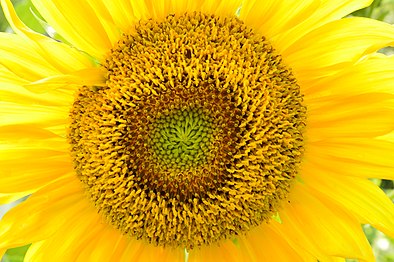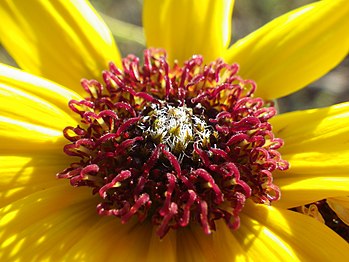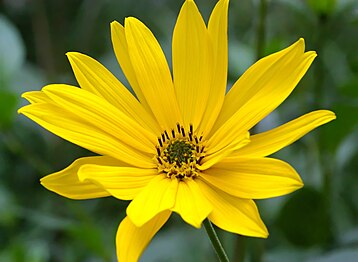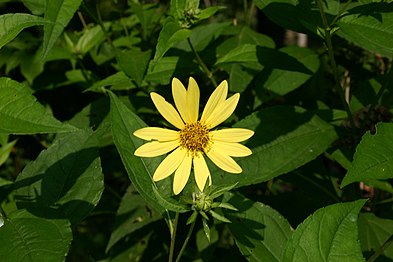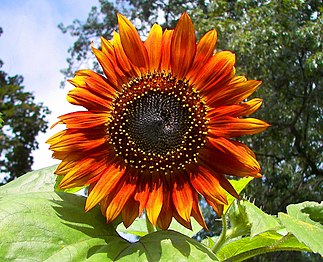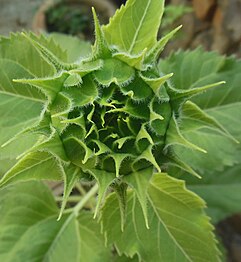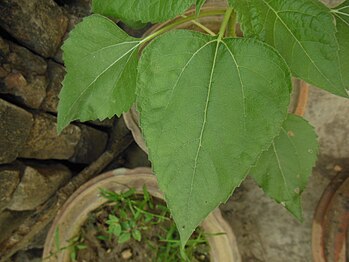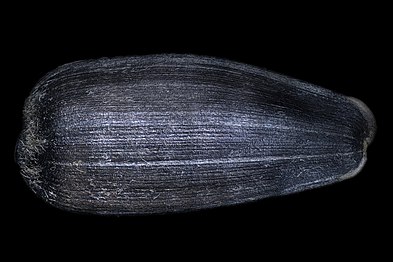Helianthus
| Helianthus | |
|---|---|
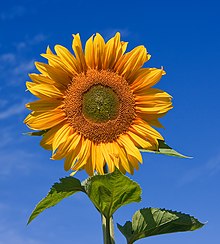
| |
| Common sunflower(Helianthus annuus) | |
| Scientific classification | |
| Kingdom: | Plantae |
| Clade: | Tracheophytes |
| Clade: | Angiosperms |
| Clade: | Eudicots |
| Clade: | Asterids |
| Order: | Asterales |
| Family: | Asteraceae |
| Subfamily: | Asteroideae |
| Tribe: | Heliantheae |
| Subtribe: | Helianthinae |
| Genus: | Helianthus L.[1] |
| Synonyms[1][2] | |
|
Harpalium(Cass.) Cass. | |
Helianthus(/ˌhiːliˈænθəs/)[3]is agenuscomprising about 70speciesof annual and perennialflowering plantsin the daisy familyAsteraceaecommonly known assunflowers.[4][5]Except for threeSouth Americanspecies, the species ofHelianthusare native toNorth AmericaandCentral America.The best-known species is thecommon sunflower(Helianthus annuus).[6]This and other species, notablyJerusalem artichoke(H. tuberosus), are cultivated intemperateregions and sometropicalregions, as food crops for humans, cattle, and poultry, and as ornamental plants.[7]The speciesH. annuustypically grows during the summer and into early fall, with the peak growth season being mid-summer.[8]
SeveralperennialHelianthusspecies are grown in gardens, but have a tendency to spread rapidly and can become aggressive. On the other hand, the whorled sunflower,Helianthus verticillatus,was listed as anendangeredspecies in 2014 when theU.S. Fish and Wildlife Serviceissued a final rule protecting it under theEndangered Species Act.The primary threats areindustrial forestryandpineplantations in Alabama, Georgia, and Tennessee. They grow to 1.8 metres (6 feet) and are primarily found in woodlands, adjacent to creeks and moist, prairie-like areas.[9]
The common sunflower is the national flower ofUkraine,cultivated there for several centuries.[10]
Description[edit]


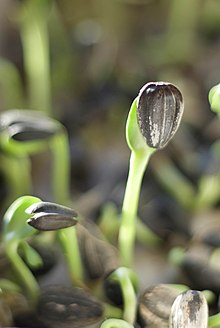
Sunflowers are usually tallannualor perennial plants that in some species can grow to a height of 300 centimetres (120 inches) or more. Each "flower" is actually a disc made up of tiny flowers, to form a larger false flower to better attract pollinators. The plants bear one or more wide, terminalcapitula(flower heads made up of many tiny flowers), with bright yellow rayflorets(mini flowers inside a flower head) at the outside and yellow or maroon (also known as a brown/red) disc florets inside. Several ornamentalcultivarsofH. annuushave red-colored ray florets; all of them stem from a single original mutant.[11]While the majority of sunflowers are yellow, there are branching varieties in other colors including, orange, red and purple.
Thepetiolateleavesare dentate and often sticky. The lower leaves are opposite,ovate,or often heart-shaped. The rough and hairystemis branched in the upper part in wild plants, but is usually unbranched in domesticated cultivars.[12]
This genus is distinguished technically by the fact that the ray florets (when present) are sterile, and by the presence on the disk flowers of apappusthat is of two awn-like scales that arecaducous(that is, easily detached and falling at maturity). Some species also have additional shorter scales in the pappus, and one species lacks a pappus entirely. Another technical feature that distinguishes the genus more reliably, but requires a microscope to see, is the presence of a prominent, multicellular appendage at the apex of the style. Further, the florets of a sunflower are arranged in a naturalspiral.[13]
Variability is seen among the perennial species that make up the bulk of those in the genus. Some have most or all of the large leaves in a rosette at the base of the plant and produce a flowering stem that has leaves that are reduced in size. Most of the perennials have disk flowers that are entirely yellow, but a few have disk flowers with reddish lobes. One species,H. radula,lacks ray flowers altogether.
Overall, the macroevolution of theHelianthusis driven by multiple biotic and abiotic factors and influences various floral morphology.[14]
Helianthusspecies are used as food plants by thelarvaeof many lepidopterans.
Growth stages[edit]
The growth of a sunflower depends strictly on its genetic makeup and background.[15]Additionally, the season it is planted will have effects on its development; those seasons tend to be in the middle of summer and beginning of fall. Sunflower development is classified by a series of vegetative stages and reproductive stages that can be determined by identifying the heads or main branch of a single head or branched head.[15]
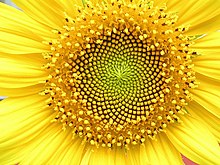
Facing the Sun (heliotropism)[edit]
Before blooming,Helianthusplant heads tilt during the day to face theSun.This movement is referred to asheliotropism,which continues for a short time when flower buds form and youngHelianthusheads track the Sun. At night, the flower heads reorient their position and face East in anticipation for the sunrise.[16]Sunflowers move back to their original position between 3am and 6am, and the leaves follow about an hour later.[17]
By the time they are mature and reachanthesis,Helianthusgenerally stop moving and remain facing east, which lets them be warmed by the rising sun.[12]Historically, this has led to controversy on whether or notHelianthusis heliotropic, as many scientists have failed to observe movement when studying plants that have already bloomed.[16]
This is notably different from heliotropism in leaves, as the moving mechanism for leaves exists in thepulvinus.Since flowers do not have pulvini, the movement is caused by increased growth rate of the stems.[16][18]The growth rate accumulation of the stem on the east side of the stem gradually pushes the flower from east to west during daytime. This matches with the Sun as it rises from the east and falls in the west. At night, the growth rate is higher in the west side of the stem that gradually pushes the flower from the west side back to the east side.[18]In addition, it is not actually the whole plant that changes its direction to face the Sun, but the flower itself that bends to be illuminated by the Suns rays.[citation needed]
The heliotropic movement is caused by growth on the opposite side of the flower, driven by accumulation of growth hormones during Sun exposure.[12][19]
Heliotropism persists on cloudy days when the sun is not shining brightly, meaning that the movement isendogenousas a trained and continuous process.[16]However, flower movement does not occur during long periods of rain or clouds. It also does not occur in a growth chamber when exposed to 16 hours of light or in greenhouses, suggesting that the plants require a directional, moving light source.[17][16]Helianthus can also discriminate between different types of light.[16]When exposed to different light frequencies, thehypocotylswill bend toward blue light but not red light, depending on the quality of the light source.
It is the circadian rhythms and the differences of the stem growth rate that work together and cause the heliotropism of theHelianthus.This is important for attracting pollinators and increasing growth metabolism. Future studies are needed for identifying the exact physiological basis and cellular mechanism for this behavior.
Taxonomy[edit]
Helianthusis derived from Greekἥλιοςhēlios"sun" andἄνθοςánthos"flower",[20]because its round flower heads in combination with theliguleslook like theSun.[6]
There are many species recognized in the genus:[2][21]
- Helianthus agrestisPollard– southeastern sunflower –Florida,Georgia
- Helianthus ambiguusBritt.–Wisconsin,Michigan,Ohio,New York
- Helianthus angustifoliusL.– swamp sunflower –Texas,northernFloridato southernIllinois,Long Island,New York
- Helianthus annuusL.– common sunflower,girasol– most of United States + Canada
- Helianthus anomalusS.F.Blake– western sunflower –Nevada,Utah,Arizona,New Mexico
- Helianthus argophyllusTorr. & A.Gray– silverleaf sunflower –Texas,North Carolina,Florida
- Helianthus arizonensisR.C.Jacks.– Arizona sunflower – Arizona, New Mexico
- Helianthus atrorubensL.– purpledisk sunflower –Louisiana,Alabama,Georgia, Florida,South Carolina,North Carolina,Tennessee,Kentucky,Virginia
- Helianthus bolanderiA.Gray– serpentine sunflower –California,Oregon
- Helianthus × brevifoliusE.Watson– Texas,Indiana,Ohio
- Helianthus californicusDC.– California sunflower –California
- Helianthus carnosusSmall– lakeside sunflower – Florida
- Helianthus ciliarisDC.– Texas blueweed – United States:Washington,California, Arizona, New Mexico, Nevada, Utah, Texas,Oklahoma,Colorado,Kansas,Illinois; Mexico:Tamaulipas,Coahuila,Chihuahua,Sonora
- Helianthus cinereusSmall–Missouri,Kentucky, Indiana, Ohio
- Helianthus coloradensisCockerell– prairie sunflower – Colorado, New Mexico
- Helianthus cusickiiA.Gray– Cusick's sunflower – Washington, Oregon, California,Idaho,Nevada
- Helianthus debilisNutt.– cucumberleaf sunflower – Texas toMaine,Mississippi
- Helianthus decapetalusL.– thinleaf sunflower – eastern United States;Ontario,Quebec
- Helianthus deserticolaHeiser– desert sunflower –Arizona,Nevada,Utah
- Helianthus deverniiT.M.Draper– red rock sunflower –Nevada
- †Helianthus diffususSims– Missouri†
- Helianthus dissectifoliusR.C.Jacks.–Chihuahua,Durango
- Helianthus divaricatusL.– woodland sunflower or rough woodland sunflower – eastern United States; Ontario, Quebec
- Helianthus × divariserratusR.W.LongMichigan, Indiana, Ohio,Connecticut
- Helianthus × doronicoidesLam.– Texas,Oklahoma,Arkansas,Missouri,Iowa,Minnesota,Illinois, Kentucky, Indiana, Ohio,Pennsylvania,Michigan,New Jersey,Virginia
- Helianthus eggertiiSmall– Alabama, Kentucky, and Tennessee
- Helianthus exilisA.Gray– California
- Helianthus floridanusA.Gray ex Chapm.– Florida sunflower – Louisiana, Alabama, Georgia, Florida, South Carolina, North Carolina
- Helianthus giganteusL.– giant sunflower – eastern United States; most of Canada
- Helianthus glaucophyllusD.M.Sm– whiteleaf sunflower – Tennessee, South Carolina, North Carolina
- Helianthus × glaucusSmall– scattered locales in southeastern United States
- Helianthus gracilentusA.Gray– slender sunflower – California
- Helianthus grosseserratusM.Martens– sawtooth sunflower –Great Plains,Great Lakes,Ontario, Quebec
- Helianthus heterophyllusNutt.– variableleaf sunflower – Coastal plain of Texas to North Carolina
- Helianthus hirsutusRaf.– hairy sunflower – central and eastern United States, Ontario
- Helianthus×intermediusR.W.Long– intermediate sunflower – scattered locales in United States
- Helianthus laciniatusA.Gray– alkali sunflower – United States: Arizona, New Mexico, Texas; Mexico:Coahuila,Nuevo León
- Helianthus×laetiflorusPers.– cheerful sunflower, mountain sunflower – scattered in eastern and central United States; Canada
- Helianthus laevigatusTorr. & A.Gray– smooth sunflower – Georgia, South Carolina, North Carolina, Virginia, Maryland,West Virginia
- Helianthus lenticularisDouglas ex Lindl.Minnesota to North Dakota, Idaho, Missouri, Texas
- Helianthus longifoliusPursh– longleaf sunflower – Alabama, Georgia, North Carolina
- Helianthus × luxurians(E.Watson) E.Watson–Great Lakesregion
- Helianthus maximilianiSchrad.– Maximillian sunflower – much of United States and Canada
- Helianthus membranifoliusPoir.– Cayenne IslandFrench Guiana
- Helianthus microcephalusTorr. & A.Gray– eastern United States
- Helianthus mollisLam.– downy sunflower, ashy sunflower – Ontario, eastern and central United States
- Helianthus multiflorusL.– manyflower sunflower – Ohio
- Helianthus navarriPhil.–Chile
- Helianthus neglectusHeiser– neglected sunflower – New Mexico, Texas
- Helianthus niveus(Benth.) Brandegee– showy sunflower – United States: California,Arizona;Mexico:Baja California,Baja California Sur
- Helianthus nuttalliiTorr. & A.Gray –western and central United States, Canada
- Helianthus occidentalisRiddell– fewleaf sunflower, western sunflower – Great Lakes region, scattered in southeastern United States
- Helianthus × orgyaloidesCockerell– Colorado, Kansas
- Helianthus paradoxusHeiser– paradox sunflower – Utah, New Mexico, Texas
- Helianthus pauciflorusNutt.– stiff sunflower – central United States, Canada
- Helianthus petiolarisNutt.– prairie sunflower, lesser sunflower – much of United States, Canada
- Helianthus porteri(A.Gray) Pruski– Porter's sunflower – Alabama, Georgia, South Carolina, North Carolina
- Helianthus praecoxEngelm. & A.GrayTexas sunflower – Texas
- †Helianthus praetermissus– New Mexico sunflower – New Mexico†
- Helianthus pumilusNutt.– little sunflower – Colorado,Wyoming,Montana,Utah, Idaho
- Helianthus radula(Pursh) Torr. & A.Gray– rayless sunflower – Louisiana, Mississippi, Alabama, Georgia, South Carolina, Florida
- Helianthus resinosusSmall– resindot sunflower – Mississippi, Alabama, Georgia, South Carolina, North Carolina, Florida
- Helianthus salicifoliusA.Dietr.– willowleaf sunflower – Texas, Oklahoma, Kansas, Missouri, Illinois, Wisconsin, Ohio, Pennsylvania, New York
- Helianthus sarmentosusRich.– French Guiana
- Helianthus scaberrimusElliott– South Carolina
- Helianthus schweinitziiTorr. & A.Gray– Schweinitz's sunflower – South Carolina, North Carolina
- Helianthus silphioidesNutt.– rosinweed sunflower –Lower Mississippi Valley
- Helianthus simulansE.Watson– muck sunflower – southeastern United States
- Helianthus smithiiHeiser– Smith's sunflower – Alabama, Georgia, Tennessee
- Helianthus speciosusHook.–Michoacán
- Helianthus strumosusL.– eastern and central United States, Canada
- Helianthus subcanescens(A.Gray) E.Watson–Manitoba,north-central United States
- Helianthus subtuberosusBourg.
- Helianthus tuberosusL.– Jerusalem artichoke, sunchoke, earth-apple, topinambur – much of United States and Canada
- Helianthus verticillatusSmall– whorled sunflower – Alabama, Georgia, Tennessee
Formerly included[edit]
The following species were previously included in the genusHelianthus.[2]
- Flourensia thurifera(Molina) DC.(asH. thuriferMolina)
- Flourensia thurifera(Molina) DC.(asH. navarri)Phil.[22]
- Helianthella quinquenervis(Hook.) A.Gray(asH. quinquenervisHook.)
- Helianthella uniflora(Nutt.) Torr. & A.Gray(asH. uniflorusNutt.)
- Pappobolus imbaburensis(Hieron.) Panero(asH. imbaburensisHieron.)
- Viguiera procumbens(Pers.) S.F.Blake(asH. procumbensPers.)
Uses[edit]
TheseedsofH. annuusare used as human food. Mostcultivarsof sunflower are variants ofH. annuus,but four other species (allperennials) are also domesticated. This includesH. tuberosus,theJerusalem artichoke,which produces edible tubers.
There are many species in the sunflower genusHelianthus,and many species in other genera that may be called sunflowers.
- The Maximillian sunflower (Helianthus maximiliani) is one of 38 species ofperennial sunflowernative toNorth America.TheLand Instituteand other breeding programs are currently exploring the potential for these as a perennial seed crop.
- The sunchoke (Jerusalem artichokeorHelianthus tuberosus) is related to the sunflower, another example ofperennial sunflower.
- The Mexican sunflower isTithoniarotundifolia.It is only very distantly related to North American sunflowers.
- False sunflower refers to plants of the genusHeliopsis.
Ecology[edit]

Sunflowers have been proven to be excellent plants to attract beneficial insects, including pollinators.Helianthus spp.are a nectar producing flowering plant that attract pollinators and parasitoids which reduce the pest populations in nearby crop vegetation. Sunflowers attract different beneficial pollinators (e.g., honey bees) and other known insect prey to feed on and control the population of parasitic pests that could be harmful to the crops.[23]Predacious insects are first attracted to sunflowers once they are planted. Once theHelianthus spp.reaches six inches and produces flowers it begins to attract more pollinators. Distance between sunflower rows and crop vegetation plays an important role in this phenomenon, hypothesizing that closer proximity to the crops will increase insect attraction.[23]
In addition to pollinators ofHelianthus spp., there are other factors such as abiotic stress,florivory,and disease which also contribute to the evolution of floral traits. These selective pressures, which stem from several biotic and abiotic factors are associated with habitat environmental conditions which all play a role in the overall morphology of the sunflowers' floral traits.[24]
An ecosystem is composed of both biotic (which are living elements of an ecosystem such as plants, animals, fungi, protists, and bacteria), and abiotic factors (non-living elements of an ecosystem such as air, soil, water, light, salinity and temperature).[25]
It is thought that two biotic factors can explain for the evolution of larger sunflowers and why they are present in more drier environments.[24]For one thing, the selection by pollinators is thought to have increased the sunflower's size in a drier environment.[24]This is because in a drier environment, there are typically less pollinators.[24]As a result, in order for the sunflower to be able to attract more pollinators, they had to increase the morphology of their floral traits in that they had to increase their display size.[24]Another biotic factor that can explain for the evolution of larger sunflowers in drier environments is that the pressure from florivory and disease favors smaller flowers in habitats that have a more moderate supply of moisture (mesic habitat).[24]Wetter environments usually have more dense vegetation, more herbivores, and more surrounding pathogens.[24]As larger flowers are typically more susceptible to disease and florivory, smaller flowers may have evolved in wetter environments which explains the evolution of larger sunflowers in more drier environments.[24]
Gallery[edit]
-
Close-up of a sunflower head
-
Helianthus decapetalus
"Plenus" -
Prairie sunflower
(H. petiolaris) -
Giant sunflower
(H. giganteus) -
Jerusalem artichoke
(H. tuberosus) -
H. laetiflorus
-
Willowleaf sunflower
(H. salicifolius) -
H. annuus
-
An orange-red sunflower
-
A dark red sunflower cultivar
-
Sunflower bud
-
Rear view of a sunflower head
-
Leaves of a sunflower plant
-
Sunflower leaf structure
-
Seed under a microscope
See also[edit]
References[edit]
- ^ab"Helianthus".Germplasm Resources Information Network.Agricultural Research Service,United States Department of Agriculture.Retrieved22 February2011.
- ^abc"HelianthusL. "World Flora Online.World Flora Consortium. 2023.Retrieved8 February2023.
- ^Sunset Western Garden Book.Leisure Arts. 1995. pg. 606–607.
- ^Schilling, Edward E. (2006)."Helianthus".In Flora of North America Editorial Committee (ed.).Flora of North America North of Mexico (FNA).Vol. 21. New York and Oxford: Oxford University Press – via eFloras.org,Missouri Botanical Garden,St. Louis, MO &Harvard University Herbaria,Cambridge, MA.
- ^"Sunflower Production".North Dakota State University.Archivedfrom the original on 18 August 2016.Retrieved12 July2016.
- ^abShorter Oxford English Dictionary(6th ed.). United Kingdom: Oxford University Press. 2007. p. 3804.ISBN978-0-19-920687-2.
- ^RHS A-Z Encyclopedia of Garden Plants.United Kingdom: Dorling Kindersley. 2008. p. 1136.ISBN978-1-4053-3296-5.
- ^"Conservation Plant Characteristics - Helianthus annuus L. common sunflower HEAN3".USDA - Natural Resources Conservation Service.Retrieved1 April2019.
- ^Remillard, Ashley (August 4, 2014)"U.S. Fish and Wildlife Service Issues Final Rule Protecting Three Flowers"Archived2014-08-12 at theWayback MachineEndangered Species Law and Policy Blog,Nossaman LLP
- ^Sommerlad, Joe (10 April 2022)."What Is The National Flower Of Ukraine?".independent.co.uk.Independent.Retrieved2022-08-03.
- ^Heiser, C.B.The Sunflower.University of Oklahoma Press. 1981.
- ^abcAtamian, Hagop S.; Creux, Nicky M.; Brown, Evan A.; Garner, Austin G.; Blackman, Benjamin K.; Harmer, Stacey L. (2016-08-04)."Circadian regulation of sunflower heliotropism, floral orientation, and pollinator visits".Science.353(6299): 587–590.Bibcode:2016Sci...353..587A.doi:10.1126/science.aaf9793.ISSN0036-8075.PMID27493185.
- ^Ben Sparks."Geogebra: Sunflowers are irrationally pretty".
- ^Mason, Chase M.; Patel, Hiral S.; Davis, Kaleigh E.; Donovan, Lisa A. (2017)."Beyond pollinators: evolution of floral architecture with environment across the wild sunflowers (Helianthus, Asteraceae)".Plant Ecology and Evolution.150(2): 139–150.doi:10.5091/plecevo.2017.1321.ISSN2032-3913.JSTOR44945441.

- ^abBerglund, Duane."Sunflower Production".ag,ndsu.NDSU Extension Service and N.D. Agricultural Experiment Station.RetrievedFeb 7,2019.
- ^abcdefVandenbrink, Joshua P.; Brown, Evan A.; Harmer, Stacey L.; Blackman, Benjamin K. (July 2014)."Turning heads: The biology of solar tracking in sunflower".Plant Science.224:20–26.Bibcode:2014PlnSc.224...20V.doi:10.1016/j.plantsci.2014.04.006.PMID24908502.S2CID887356.
- ^abKutschera, Ulrich; Briggs, Winslow R. (January 2016)."Phototropic solar tracking in sunflower plants: an integrative perspective".Annals of Botany.117(1): 1–8.doi:10.1093/aob/mcv141.ISSN0305-7364.PMC4701145.PMID26420201.
- ^abAtamian, Hagop S.; Creux, Nicky M.; Brown, Evan A.; Garner, Austin G.; Blackman, Benjamin K.; Harmer, Stacey L. (2016-08-05)."Circadian regulation of sunflower heliotropism, floral orientation, and pollinator visits".Science.353(6299): 587–590.Bibcode:2016Sci...353..587A.doi:10.1126/science.aaf9793.ISSN0036-8075.PMID27493185.S2CID206650484.
- ^"How Sunflowers Move to Follow the Sun".UC Berkeley Rausser College of Natural Resources.Retrieved2020-05-01.
- ^Weekley, Ernest (1921)."helianthus".An etymological dictionary of modern English.London: John Murray. p. 703.
- ^"Helianthus".County-level distribution maps from the North American Plant Atlas (NAPA).Biota of North America Program (BONAP). 2014.
- ^"Helianthus navarri Phil. | Plants of the World Online | Kew Science".
- ^abJones, Gregory A.; Gillett, Jennifer L. (March 2005)."Intercropping with Sunflowers to Attract Beneficial Insects in Organic Agriculture".Florida Entomologist.88(1): 91–96.doi:10.1653/0015-4040(2005)088[0091:IWSTAB]2.0.CO;2.ISSN0015-4040.
- ^abcdefghMason, Chase M.; Patel, Hiral S.; Davis, Kaleigh E.; Donovan, Lisa A. (2017-07-10)."Beyond pollinators: evolution of floral architecture with environment across the wild sunflowers (Helianthus, Asteraceae)".Plant Ecology and Evolution.150(2): 139–150.doi:10.5091/plecevo.2017.1321.
- ^"Abiotic & Biotic Factors in Ecosystems".Sciencing.Retrieved2021-02-20.

